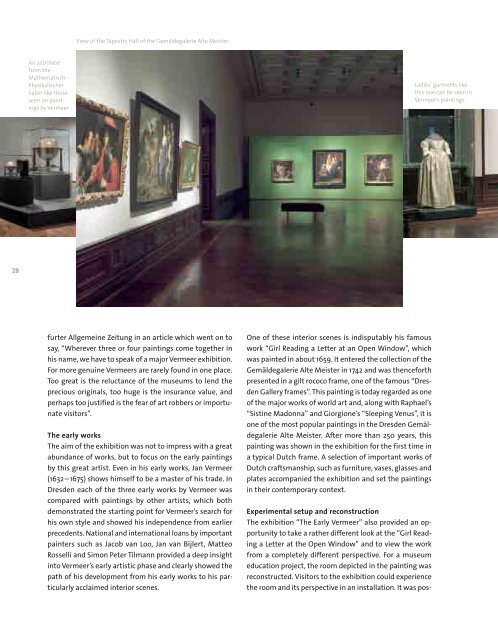Annual Report 2010 - Staatliche Kunstsammlungen Dresden
Annual Report 2010 - Staatliche Kunstsammlungen Dresden
Annual Report 2010 - Staatliche Kunstsammlungen Dresden
You also want an ePaper? Increase the reach of your titles
YUMPU automatically turns print PDFs into web optimized ePapers that Google loves.
28<br />
an astrolabe<br />
from the<br />
Mathematisch-<br />
Physikalischer<br />
salon like those<br />
seen on paintings<br />
by Vermeer<br />
View of the Tapestry Hall of the Gemäldegalerie alte Meister<br />
furter Allgemeine Zeitung in an article which went on to<br />
say, “Wherever three or four paintings come together in<br />
his name, we have to speak of a major Vermeer exhibition.<br />
For more genuine Vermeers are rarely found in one place.<br />
Too great is the reluctance of the museums to lend the<br />
precious originals, too huge is the insurance value, and<br />
perhaps too justified is the fear of art robbers or importunate<br />
visitors”.<br />
the early works<br />
The aim of the exhibition was not to impress with a great<br />
abundance of works, but to focus on the early paintings<br />
by this great artist. Even in his early works, Jan Vermeer<br />
(1632 – 1675) shows himself to be a master of his trade. In<br />
<strong>Dresden</strong> each of the three early works by Vermeer was<br />
compared with paintings by other artists, which both<br />
demonstrated the starting point for Vermeer’s search for<br />
his own style and showed his independence from earlier<br />
precedents. National and international loans by important<br />
painters such as Jacob van Loo, Jan van Bijlert, Matteo<br />
Rosselli and Simon Peter Tilmann provided a deep insight<br />
into Vermeer’s early artistic phase and clearly showed the<br />
path of his development from his early works to his particularly<br />
acclaimed interior scenes.<br />
One of these interior scenes is indisputably his famous<br />
work “Girl Reading a Letter at an Open Window”, which<br />
was painted in about 1659. It entered the collection of the<br />
Gemäldegalerie Alte Meister in 1742 and was thenceforth<br />
presented in a gilt rococo frame, one of the famous “<strong>Dresden</strong><br />
Gallery frames”. This painting is today regarded as one<br />
of the major works of world art and, along with Raphael’s<br />
“Sistine Madonna” and Giorgione’s “Sleeping Venus”, it is<br />
one of the most popular paintings in the <strong>Dresden</strong> Gemäldegalerie<br />
Alte Meister. After more than 250 years, this<br />
painting was shown in the exhibition for the first time in<br />
a typical Dutch frame. A selection of important works of<br />
Dutch craftsmanship, such as furniture, vases, glasses and<br />
plates accompanied the exhibition and set the paintings<br />
in their contemporary context.<br />
experimental setup and reconstruction<br />
The exhibition “The Early Vermeer” also provided an opportunity<br />
to take a rather different look at the “Girl Reading<br />
a Letter at the Open Window” and to view the work<br />
from a completely different perspective. For a museum<br />
education project, the room depicted in the painting was<br />
reconstructed. Visitors to the exhibition could experience<br />
the room and its perspective in an installation. It was pos<br />
Ladies’ garments like<br />
this one can be seen in<br />
Vermeer’s paintings

















